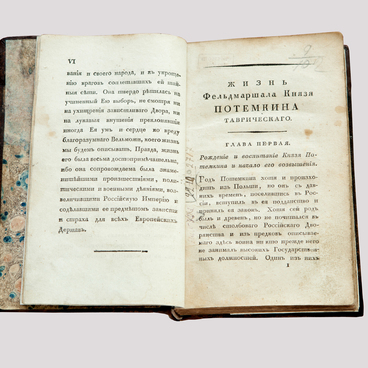Empress Catherine II visited Smolensk twice. On her first visit in 1780, Ekaterina Alekseevna met in Smolensk with the Austrian Emperor Joseph II. In memory of Joseph’s evening walk in the center of Smolensk, the city garden Blonie was established.
In January 1787, while traveling to the Crimea, the empress stopped in Smolensk, where she gave balls, baptized the children of the Smolensk nobles, and was engaged in philanthropy. “The Journal of Her Imperial Majesty”s Journey to the Meridian Countries” contains a description of this Catherine’s visit to Smolensk. The Smolensk nobility kept the memory of this visit for a long time. It is no coincidence that in many houses and institutions of the city there were portraits of the great empress.
One of these portraits was acquired by the museum in 1923. The portrait was recorded in the book of receipts as the work of the artist Sablukov.
Russian artist Ivan Semyonovich Sablukov was born in 1735. As a child, possessing a wonderful voice, Ivan was brought to St. Petersburg and assigned to the group of court singers. In 1753, the group of singers was disbanded due to their maturity and changing voices. The teenagers were transferred to art training. Sablukov was apprenticed to the artist Ivan Argunov, and later continued his painting studies under the guidance of Levitsky.
In 1762, from an apprentice, Sablukov became an associate of the Academy, and already in 1765 he was awarded the title of academician of portrait painting, a full member of the Academy of Arts.
Then, with the beginning of the reign of Catherine II, an integral system of art education was just beginning to be created, art schools were organized throughout the country. Academician Ivan Sablukov became the founder of one of the first provincial drawing schools at the Kharkov Collegium in 1767.
In the Smolensk portrait, the Empress is depicted chest-high. An ermine mantle thrown over the shoulders of Catherine is one of the unmistakably recognized symbols of imperial status. On the chest of the Empress is a ribbon and a star of the Order of St. Andrew the First-Called. The hairstyle is decorated with a diamond tiara with a drop-shaped diamond falling on the forehead. When comparing the Smolensk portrait with the famous coronation portrait of the Empress by Sablukov, it becomes clear that, most likely, we are dealing with a very free interpretation of the image created by the Ukrainian master. In the portrait from the Smolensk Museum collection, the composition, rotation, and also a significant part of the details have been changed. For example, in the portrait of Sablukov there is no star of the Order of St. Andrew the First-Called. Instead, there is a graceful diamond jewelry on the Empress’s chest. In the portrait from the Smolensk Museum, even the appearance of the empress has slightly different characteristics. It can be assumed that an unknown artist used one of the popular engravings depicting Catherine the Great as the original.
In January 1787, while traveling to the Crimea, the empress stopped in Smolensk, where she gave balls, baptized the children of the Smolensk nobles, and was engaged in philanthropy. “The Journal of Her Imperial Majesty”s Journey to the Meridian Countries” contains a description of this Catherine’s visit to Smolensk. The Smolensk nobility kept the memory of this visit for a long time. It is no coincidence that in many houses and institutions of the city there were portraits of the great empress.
One of these portraits was acquired by the museum in 1923. The portrait was recorded in the book of receipts as the work of the artist Sablukov.
Russian artist Ivan Semyonovich Sablukov was born in 1735. As a child, possessing a wonderful voice, Ivan was brought to St. Petersburg and assigned to the group of court singers. In 1753, the group of singers was disbanded due to their maturity and changing voices. The teenagers were transferred to art training. Sablukov was apprenticed to the artist Ivan Argunov, and later continued his painting studies under the guidance of Levitsky.
In 1762, from an apprentice, Sablukov became an associate of the Academy, and already in 1765 he was awarded the title of academician of portrait painting, a full member of the Academy of Arts.
Then, with the beginning of the reign of Catherine II, an integral system of art education was just beginning to be created, art schools were organized throughout the country. Academician Ivan Sablukov became the founder of one of the first provincial drawing schools at the Kharkov Collegium in 1767.
In the Smolensk portrait, the Empress is depicted chest-high. An ermine mantle thrown over the shoulders of Catherine is one of the unmistakably recognized symbols of imperial status. On the chest of the Empress is a ribbon and a star of the Order of St. Andrew the First-Called. The hairstyle is decorated with a diamond tiara with a drop-shaped diamond falling on the forehead. When comparing the Smolensk portrait with the famous coronation portrait of the Empress by Sablukov, it becomes clear that, most likely, we are dealing with a very free interpretation of the image created by the Ukrainian master. In the portrait from the Smolensk Museum collection, the composition, rotation, and also a significant part of the details have been changed. For example, in the portrait of Sablukov there is no star of the Order of St. Andrew the First-Called. Instead, there is a graceful diamond jewelry on the Empress’s chest. In the portrait from the Smolensk Museum, even the appearance of the empress has slightly different characteristics. It can be assumed that an unknown artist used one of the popular engravings depicting Catherine the Great as the original.

